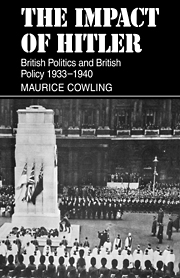Book contents
The fall of Chamberlain
Published online by Cambridge University Press: 19 October 2009
Summary
‘The government can only be changed if there is a serious breakdown among their supporters and if, as someone says to me privately, “Winston is ready to strike”’.
Dalton diary, September 19 1939‘I cannot help feeling that the principles of Liberalism really fulfil what people want, if they only could realise it’.
Crewe to Lloyd George, April 1 1940‘It is now quite clear that Winston is putting in the jackals and ousting even those who have done well of what I may call the respectable Rump of the Tory party’.
Davidson to Baldwin, May 14 1940Chamberlain's understanding of the war was accepted by Chat field — the only professional strategist — and by Halifax and Hankey, whom he regarded as the most important members of the Cabinet. Chatfield expected the war to be a long one (unless it was shortened by political collapse in Germany) ; his ultimate weapons were air power, naval blockade and economic strangulation. Neither he nor Halifax was an optimist, and Hankey was positively pessimistic (until Hitler failed to attack London). All three assumed that the essence of prudence was Fabian.
Hankey's view before joining the War Cabinet in September was not much different from the views he had expressed before retiring fourteen months before. Just as Eden's departure had given him a ‘strange sense of relief’, so Munich had ‘laid the foundations of a lasting peace’. But the commitment of September 18 had renewed the danger of a three-cornered war.
- Type
- Chapter
- Information
- The Impact of HitlerBritish Politics and British Policy 1933-1940, pp. 367 - 386Publisher: Cambridge University PressPrint publication year: 1975



